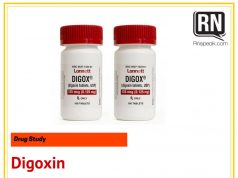Generic Name:Mannitol(man´i-tole)
Brand Name:Osmitrol
Classifications:electrolytic and water balance agent; osmotic diuretic
Pregnancy Category:C
Availability
5%, 10%, 15%, 20%, 25% injectio
Actions
In large doses, increases rate of electrolyte excretion by the kidney, particularly sodium, chloride, and potassium.
Therapeutic effects
Induces diuresis by raising osmotic pressure of glomerular filtrate, thereby inhibiting tubular reabsorption of water and solutes. Reduces elevated intraocular and cerebrospinal pressures by increasing plasma osmolality, thus inducing diffusion of water from these fluids back into plasma and extravascular space.
Uses
To promote diuresis in prevention and treatment of oliguric phase of acute kidney failure following cardiovascular surgery, severe traumatic injury, surgery in presence of severe jaundice, hemolytic transfusion reaction. Also used to reduce elevated intraocular (IOP) and intracranial pressure (ICP), to measure glomerular filtration rate (GFR), to promote excretion of toxic substances, to relieve symptoms of pulmonary edema, and as irrigating solution in transurethral prostatic reaction to minimize hemolytic effects of water. Commercially available in combination with sorbitol for urogenital irrigation.
Contraindications
Anuria; marked pulmonary congestion or edema; severe CHF; metabolic edema; organic CNS disease, intracranial bleeding; shock, severe dehydration, history of allergy; pregnancy (category C), lactation; concomitantly with blood.
Route & dosage
Acute Kidney Failure
adult:IV Test Dose 0.2 g/kg or 12.5 g as a 15%–20% solution over 3–5 min
Positive Response 30–50 mL of urine over next 2–3 h, may repeat test dose 1 time. If still negative, do not use.
Treatment 50–100 g as 15%–20% solution over 90 min to several hours
child: IV Test Dose 200 mg/kg (max: 12.5 g) over 3–5 min
Positive Response Urine flow of 1 mL/kg/h for 1–2 h
Maintenance 0.25–0.5 g/kg q4–6 h
Edema, Ascites
adult:IV 100 g as a 10%–20% solution over 2–6 h
Elevated IOP or ICP
adult:IV 1.5–2 mg/kg as a 15%–25% solution over 30–60 min
Acute Chemical Toxicity
adult:IV 100–200 g depending on urine output
Measurement of GFR
adult:IV 100 mL of 20% solution diluted with 180 mL NaCl injection infused at a rate of 20 mL/min
Administration
Intravenous
- Note: Verify correct IV concentration and rate of infusion for administration to infants, children with physician.
PREPARE IV Infusion: Give undiluted
ADMINISTER IV Infusion: Give a single dose over 30–90 min. Oliguria: A test dose is given to patients with marked oliguria to check adequacy of kidney function. Response is considered satisfactory if urine flow of at least 30–50 mL/h is produced over 2–3 h after drug administration; then rate is adjusted to maintain urine flow at 30–50 mL/h with a single dose usually being infused over >=90 min. Concentrations higher than 15% have a greater tendency to crystallize. Use an administration set with an in-line IV filter when infusing concentrations of 15% or above.
Incompatibilities Solution / Additive: Imipenem-cilastatin. Y-site: Cefepime, doxorubicin liposome, filgrastim.
Store at 15°–30° C (59°–86° F) unless otherwise directed. Avoid freezing.
Nursing implications
Assessment & Drug Effects
- Take care to avoid extravasation. Observe injection site for signs of inflammation or edema.
- Lab tests: Monitor closely serum and urine electrolytes and kidney function during therapy.
- Measure I&O accurately and record to achieve proper fluid balance.
- Monitor vital signs closely. Report significant changes in BP and signs of CHF.
- Monitor for possible indications of fluid and electrolyte imbalance (e.g., thirst, muscle cramps or weakness, paresthesias, and signs of CHF).
- Be alert to the possibility that a rebound increase in ICP sometimes occurs about 12 h after drug administration. Patient may complain of headache or confusion.
- Take accurate daily weight.
Patient & Family Education
- Report any of the following: Thirst, muscle cramps or weakness, paresthesia, dyspnea, or headache.
- Family members should immediately report any evidence of confusion.
- Do not breast feed while using this drug.







